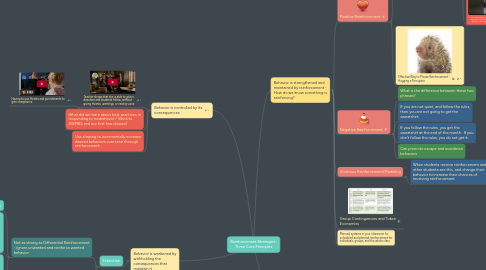
1. Behavior is strengthened and maintained by reinforcement - How do we know something is reinforcing?
1.1. Positive Reinforcement
1.1.1. Contingent and Non-Contingent Reinforcement
1.1.1.1. Contingent - Reinforce only when a certain behavior is performed
1.1.1.1.1. Mastering the 4:1 Ratio of Praise
1.1.1.2. Non-Contingent - Reinforce without having to perform a specific behavior - Donuts just 'cause!
1.1.2. Effective Way to Phrase Reinforcement - Hugging a Porcupine
1.2. Negative Reinforcement
1.2.1. What is the difference between these two phrases?
1.2.2. If you are not quiet, and follow the rules, then you are not going to get the sweatshirt.
1.2.3. If you follow the rules, you get the sweatshirt at the end of the month. If you don't follow the rules, you do not get it.
1.2.4. Can promote escape and avoidance behaviors
1.3. Vicarious Reinforcement/Modeling
1.3.1. When students receive reinforcement and other students see this, and change their behavior to increase their chances of receiving reinforcement
1.3.1.1. You are not Oprah - not everyone gets a prize all the time
1.4. Group Contingencies and Token Economies
1.5. Planned systems in your classroom for scheduled and planned reinforcement for individuals, groups, and the whole class
2. Behavior is controlled by its consequences
2.1. Teacher shows that she is able to give a direction and students follow, without giving threats, warnings, or raising voice
2.1.1. Having to use threats and punishments to gain compliance
2.2. What did we learn about best practices in responding to misbehavior? (Back to SWPBIS and our first few classes)
2.3. Use shaping to incrementally increase desired behaviors over time through reinforcement
3. Behavior is weakened by withholding the consequences that maintain it
3.1. Extinction
3.1.1. Not as strong as Differential Reinforcement - ignore unwanted and reinforce wanted behavior
3.1.1.1. Differential Reinforcement of Low Rates
3.1.1.2. Differential Reinforcement of Alternative Behavior (Functional Replacement)
3.1.1.3. Differential Reinforcement of Incompatible Behavior
3.1.2. Extinction Burst
3.1.2.1. Differential Reinforcement of Other Behaviors (everything but the problem behavior or the absence of the problem behavior)
4. The Great 8
4.1. Which strategies relate to reinforcement? How?
4.2. The best way to motivate students to do well, participate, give their best effort, and ultimately meet expectations has nothing to do with rewards and punishments
4.2.1. No matter system you use to shape behavior in the beginning of your class, you cannot rely on it to be your only way or that your students will not lose interest in it without elements of the great 8 and strong intrinsic motivation
4.2.1.1. Remember to always pair extrinsic with intrinsic motivational strategies or natural consequences and fade out the rewards over time
